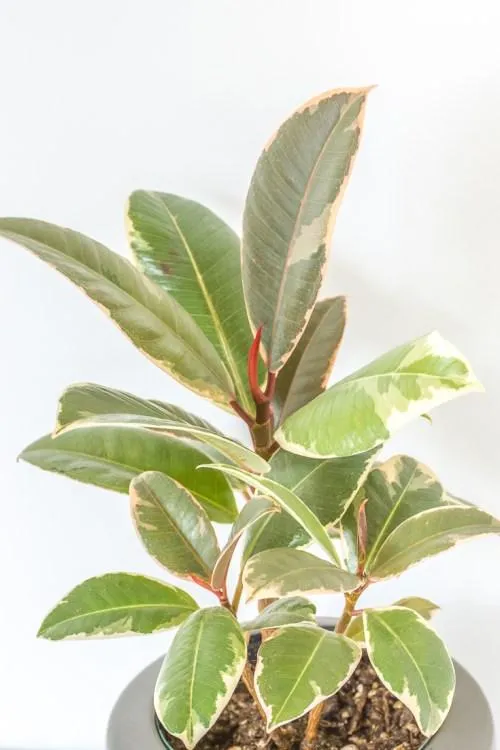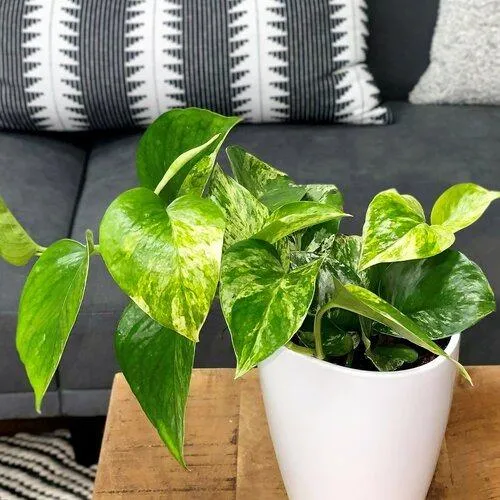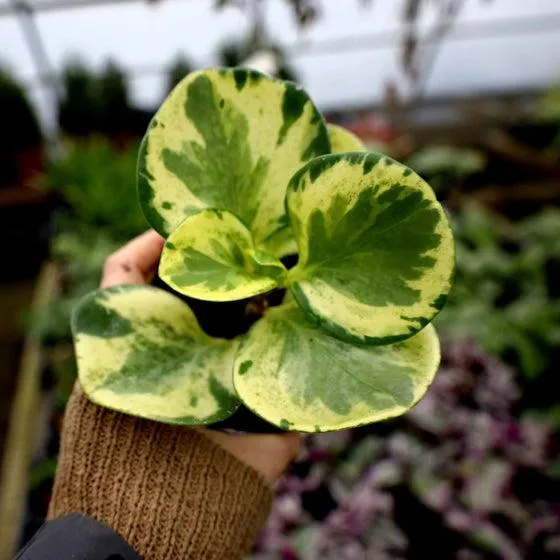Everything You Need to Know About Variegated Leaf Houseplants
If you’ve been searching for “variegated leaf houseplant”, you’ve come to the right place. Variegated plants have striking leaves with colorful markings that make them a gorgeous addition to any indoor space. In this in-depth guide, I’ll answer all your questions about caring for, propagating, and choosing the best variegated houseplants.
What is a Variegated Plant?
Put simply, a variegated plant is one with leaves featuring contrasting colors other than just solid green. The most common type has streaks or splotches of white, yellow, pink or light green on green leaves. This divergent coloring is caused by a genetic mutation that prevents some areas of the leaf from producing chlorophyll, the pigment that makes plants green. Without chlorophyll, other pigments like carotenoids are able to shine through.
Popular Variegated Houseplant Types
- Pothos – Its heart-shaped leaves come in creamy white and green or yellow and green variegations. Pothos is incredibly low maintenance.
- Philodendron – Look for varieties like ‘Brasil’ with its bright yellow variegation. Philodendrons are resilient and tolerate low light.
- Chinese Evergreen – With wavy green-and-white foliage, it’s a stunner. Chinese evergreens can get large but stay full and bushy.
- Peperomia – These small-leaved beauties come in countless shapes and patterns of green and off-white. They make excellent tabletop plants.
- Monstera – Who isn’t obsessed with the iconic Monstera deliciosa? The mature,split-leaf form often emerges variegated as well.
Care Tips for Variegated Plants
While low-maintenance like their solid green cousins, variegated plants do have some special care needs due to the mutation in their leaves:
Light: Most need bright, indirect sunlight to prevent the variegation from reverting back to solid green. South- or west-facing windows are perfect.
Water: Water when the top inch of soil is dry. Overwatering can cause root rot, especially in the paler sections lacking chlorophyll for photosynthesis.

Fertilizer: Feed monthly in spring and summer with a diluted liquid product. Variegated plants put more energy into their leaves and may become nutrient deficient.
Pruning: Cut off any all-green reversions as they appear to encourage the variegation to retain its pattern. To propagate, take cuttings of the variegated sections.
The key is finding the right balance. Variegated plants can be deceivingly fragile – too much sun or water will harm them. But under the right conditions, they’ll reward you with gorgeous foliage for years.
Real-life Examples of Caring for Variegated Plants
I’ll share a couple examples from my own experience caring for variegated beauties. One of my variegated pothos was struggling – its once bright leaves were becoming splotchy and curled. From my experience, I knew this indicated overwatering. I removed it from the pebble tray keeping the soil too wet and let it dry out completely. Within a few weeks, it perked right up with vibrant variegation again.
Another time, my Philodendron brasil wasn’t putting out any new growth despite getting plenty of light. I added a monthly all-purpose fertilizer and saw amazing results. Now it’s pumping out glossy green and yellow leaves non-stop. The moral is that variegated plants often need that extra boost to make the most of their unique leaves.

Frequently Asked Questions
Why do some variegated plants revert back to solid green?
Over time and with stressors like low light, the genetic mutation that causes variegation can be overcome, “healing” the plant back to having only green leaves naturally suited for photosynthesis.
How do I propagate from a variegated plant?
Take cuttings from the prettiest variegated sections, allow the cut end to callus, and root in water or soil. There’s no guarantee the new growth will be variegated too, but it’s worth a try!
Will variegation patterns remain stable or change over time?
Most patterns will hold steady, but subtle changes can occur naturally as the plant ages and puts out new growth. Keep an eye out for unstable variegation prone to reverting.
Are variegated plants higher maintenance than solid green ones?
Generally yes, as the lack of chlorophyll in some leaf areas makes them a bit more finicky. But their spectacular foliage is worth the little extra TLC they require to stay healthy.
I hope this massive explainer has covered basically every angle of variegated houseplants! Let me know if you have any other questions. These patterned plants are simply amazing – there’s a reason variegation fever has taken the plant world by storm. Even for beginners, with some attentive care they’re rewarding houseplants to grow.

Factors to Consider When Choosing a Variegated Leaf Houseplant
| Plant | Light Requirements | Water Needs | Care Tips |
|---|---|---|---|
| Peperomia | Bright indirect light | Allow soil to dry slightly between waterings | Tolerants lower light. Watch for mealybugs |
| Chinese Evergreens | Bright indirect light | Keep soil slightly moist | Sensitive to overwatering. Prune to shape |
| Pothos | Low to medium light | Allow soil to dry slightly between waterings | Vigorous grower. Tolerates neglect. Toxic to pets |
| Philodendron | Bright indirect light | Keep soil slightly moist | Large selection. Toxic to pets. Prune to shape |
| Zebra Plant | Bright light | Allow soil to dry slightly between waterings | Star shaped leaves. Tolerants low light. Toxic to pets |
FAQ
-
What types of variegated leaves are there?
Variegated leaves come in all sorts of styles, pretty much. You’ve got your typical white and green leaves, but some plants will have reddish or pinkish splotches too. A few uncommon ones even have streaks of yellow or blueshish colors. Basically, plant breeders have come up with tons of combinations over the years through selective breeding.
-
Do variegated leaves need more sunlight?
Sometimes variegated plants require slightly more sunlight than their solid green counterparts. The white or pale areas of the leaves are unable to photosynthesize, so the plant needs extra light to make up for it. At the same time, too much sun can burn the delicate colors. So finding the right light conditions takes some trial and error. A bright, east-facing window is usually a good bet.
-
Do the colors fade over time?
It’s possible for the variegation to fade on some plant varieties if they aren’t given enough light. The green chlorophyll will take over. However, the colors seem super stable on others. And even if they do fade a bit, you can cut off affected stems to encourage new growth. Maybe plant breeders will come up with varieties with even more solid coloration down the road.
-
How do you care for variegated plants?
In general, variegated plants need similar care to their all-green cousins. Water them when the soil becomes dry, feed them occasionally in the growing season, and move them to prevent sunburning the pale parts. You may find that variegated types are slightly more prone to pests, though. Keep an eye out for signs of infestations, like spider mites who seem extra fond of the white parts. But with some TLC they’ll reward you with their good looks.
-
Are variegated plants harder to care for?
Not necessarily, but there are a couple factors that can pose more challenges. As mentioned before, the lighting needs are more specific typically. And irregular watering can cause unsightly splotches as the colors shift. However, on the other hand, their variegation makes them more visible targets for bugs. So compared to a plain foliage houseplant, the care issues are maybe offset by each other. Overall they’re not too much extra work in my experience.

-
Is variegation a genetic trait?
From what experts claim, variegation seems to be caused by a genetic mutation that results in faulty chlorophyll production in certain plant cells. These cells can’t photosynthesize and appear white, yellow or other hues. The patterns are inherited and can be perpetuated through propagation. So in a way, it’s kinda like how calico cats get their coloring. Neat, eh? I find the whole thing fascinating, if I do say so myself.
-
What animals eat variegated houseplants?
Most animals will avoid variegated foliage since it offers no nutritional value, due to the lack of chlorophyll in pale parts. However, some pests have no taste, I suppose. Spider mites find the contrasting patterns irresistible, in my awful experience. Despite their mini size, they can ravage plants. On the other hand, snails and slugs will nibble coloration away given half a chance too. I guess even animals are drawn to beauty, for better or worse.
